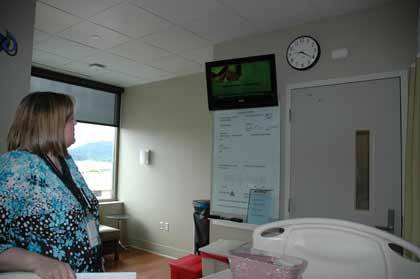At Enumclaw Regional Hospital, staff members would stand by a patient’s bedside and explain their upcoming procedure or walk them through their post-operative care. The bedside chat may have included a brochure or photocopied hand out.
Today, in the technologically advanced St. Elizabeth Hospital, patients get video-on-demand instruction on everything from obstetrics to orthopedics and general topics like wound care and crutch training.
“I think it’s great,” said Cathi Dodson, Franciscan Health System Regional nurse educator and St. Elizabeth Hospital unit based educator. “I wish we’d had this years ago when I was at the bedside. It’s so convenient.”
TeleHealth Services, the nation’s leading provider of healthcare-grade televisions and interactive patient education solutions, recently announced its partnership with the Franciscan Health System as an interactive patient education partner for St. Elizabeth Hospital in Enumclaw.
The TeleHealth TIGR system’s features will aid, among other things, the critical-access facility in achieving a paperless environment. The system delivers health-promotion, patient-safety and disease-prevention information in the patient-care setting.
Health literacy has been gaining attention under the healthcare overhaul. There’s been a call to provide plain-language materials to communicate with a variety of patient literacy levels. Statistics from TeleHealth Services note 36 percent of adults have basic/below-basic skills for dealing with health material, which means 90 million Americans can understand discharge instructions written only at a fifth-grade level or lower.
The video-on-demand system is a good fit to the interactive and visual way people learn today. It also provides material continuity across the system.
“It truly is eye-opening how few hospitals have a standardized educational program,” said Richard Bootes, vice president of development. “Video-based education is a very effective way to teach the patient. It’s truly a very gratifying experience, empowering to the family.”
A patient, or family member, dials in from their hospital bed. Voice-recording prompts instruct the patient to turn the television in their room to a specific channel. The video-on-demand provides a 7- to 10-minute tutorial.
St. Elizabeth has four dedicated channels. There are more than 100 video choices on topics from smoking cessation to total knee replacement. Most tutorials have a Spanish counterpart.
Currently the system is available at St. Elizabeth and St. Anthony Hospital in Gig Harbor.
Right now it’s used for patient education, but, Dodson said, it can also be set up in the future for patient surveys and staff education and the plan at St. Elizabeth is to move in those directions over time.
“It’s baby steps, with everything so new,” she said. “It’s a great facility and a group of people who are excited to learn.”



